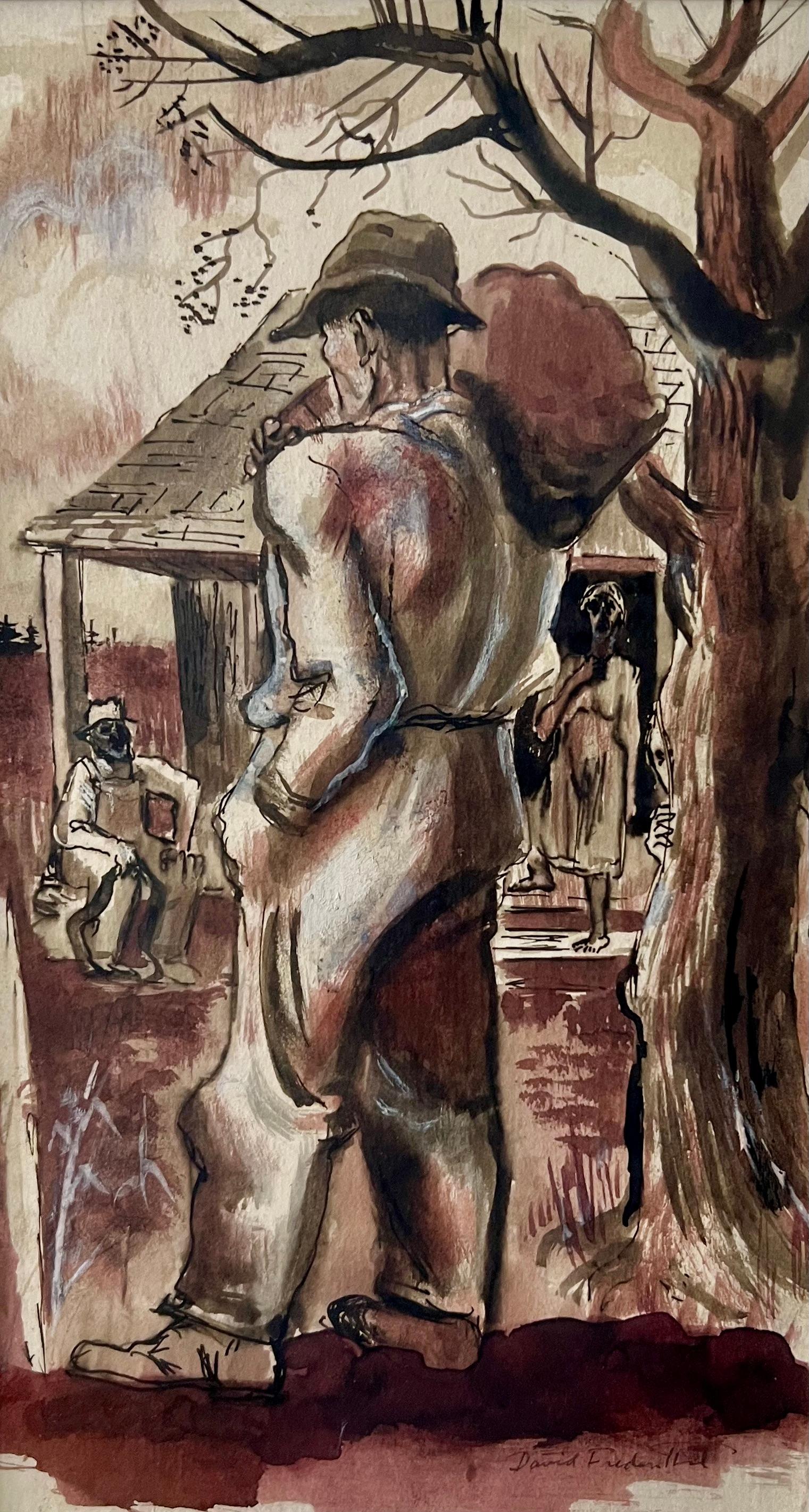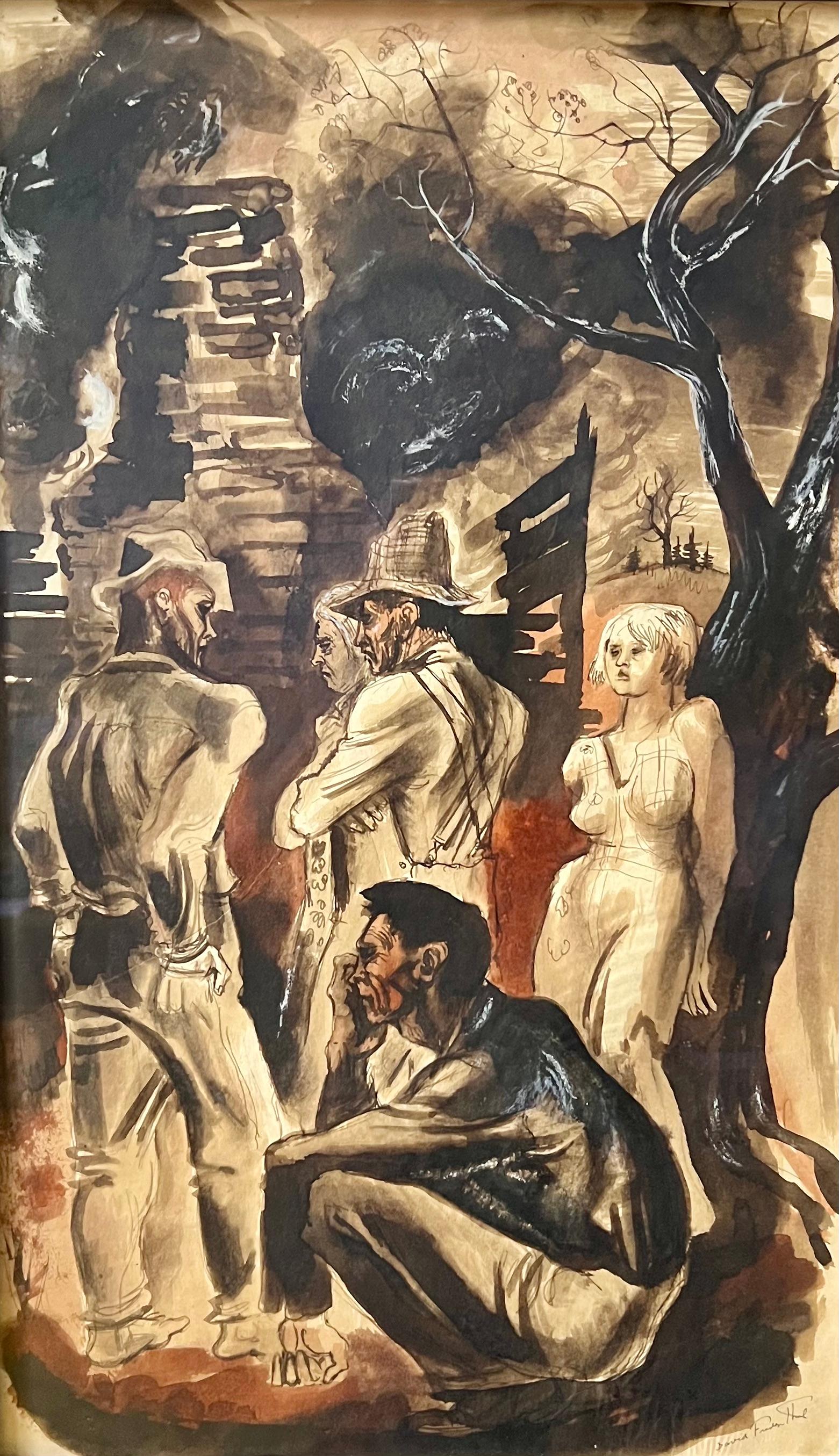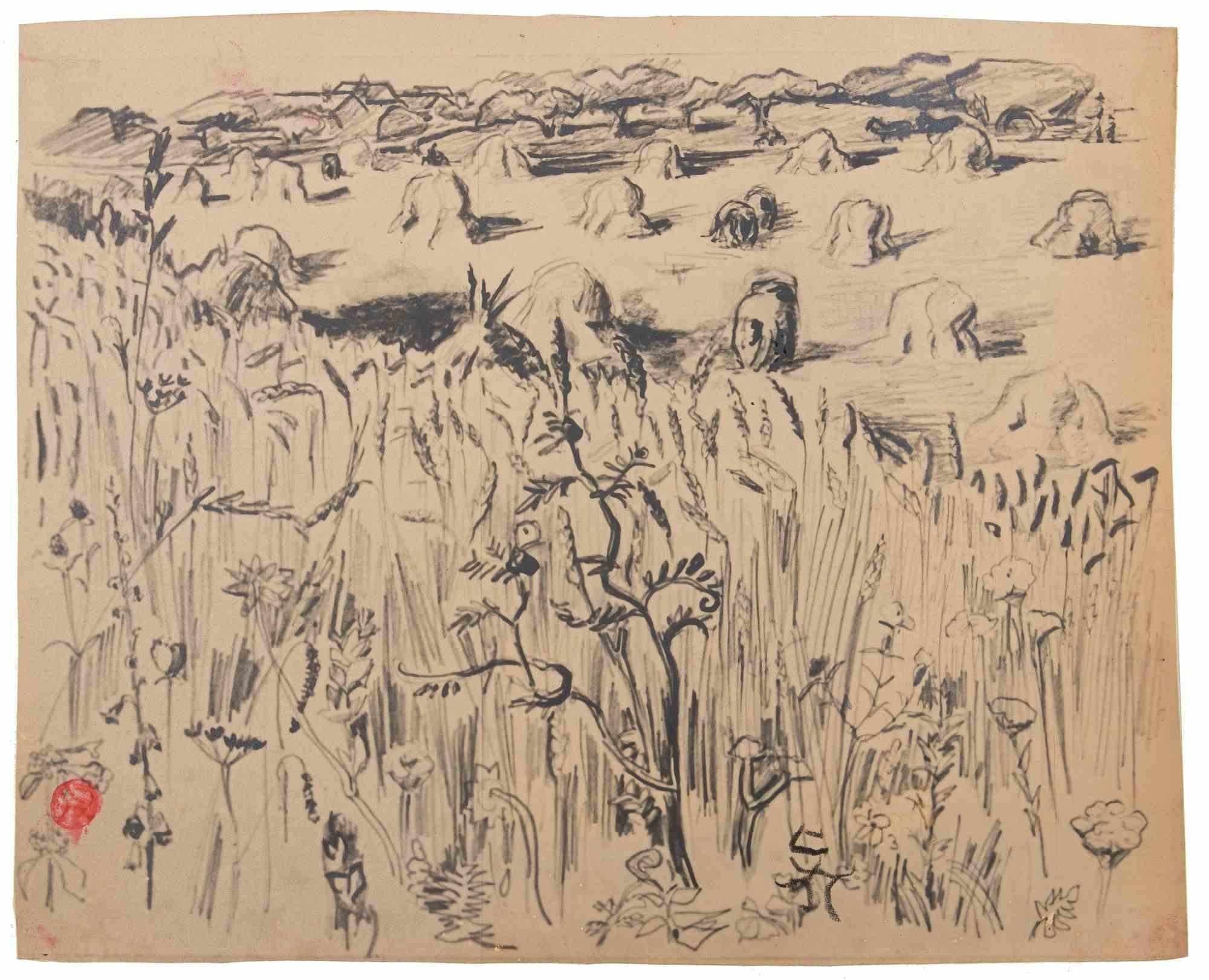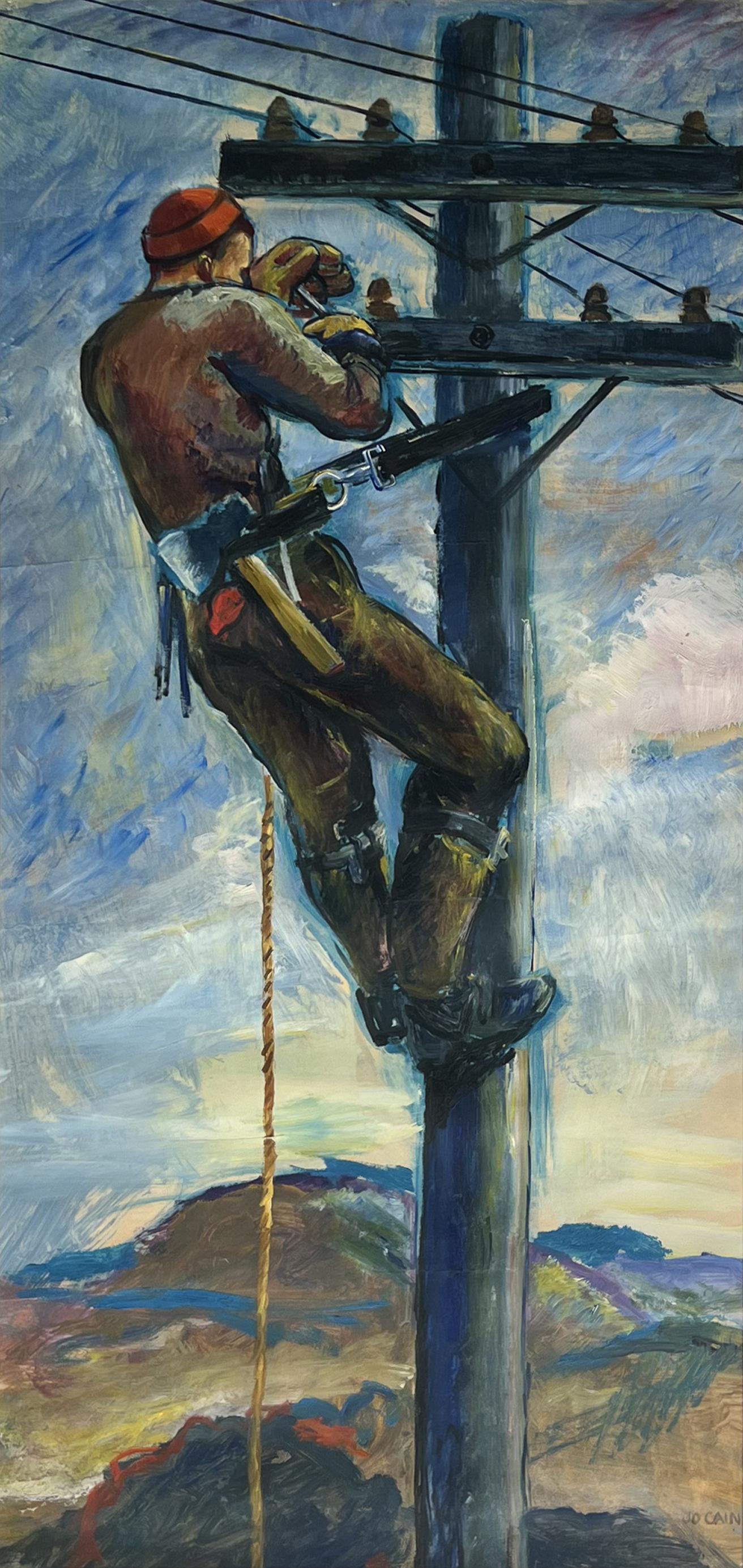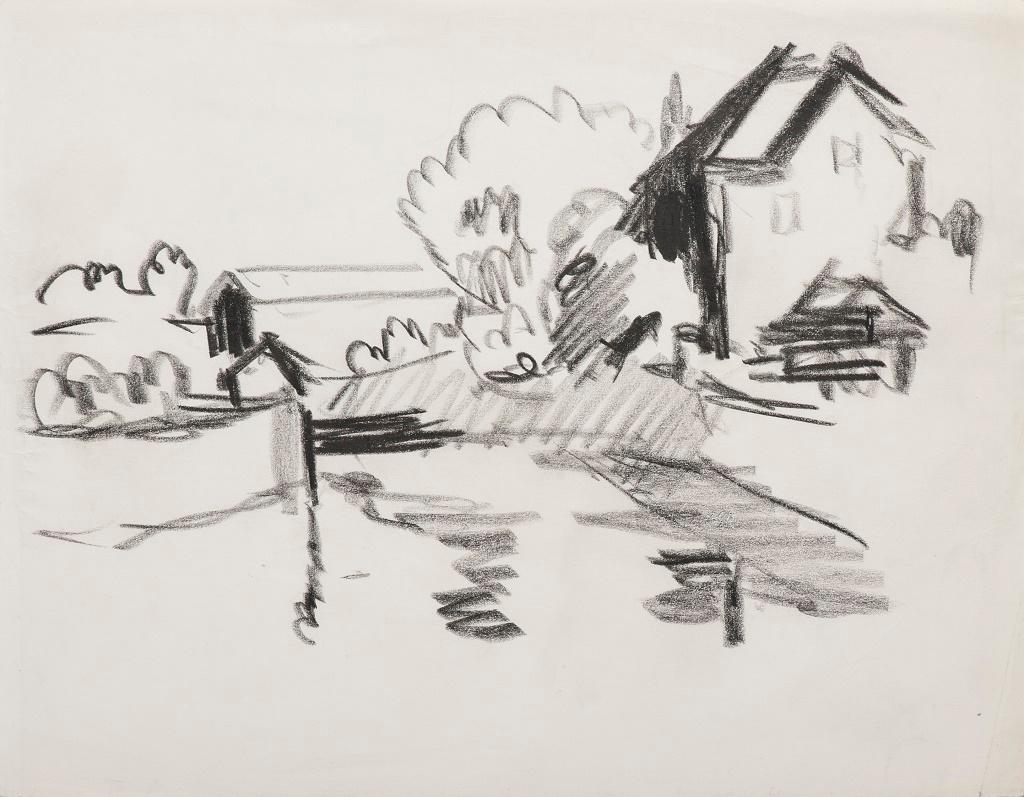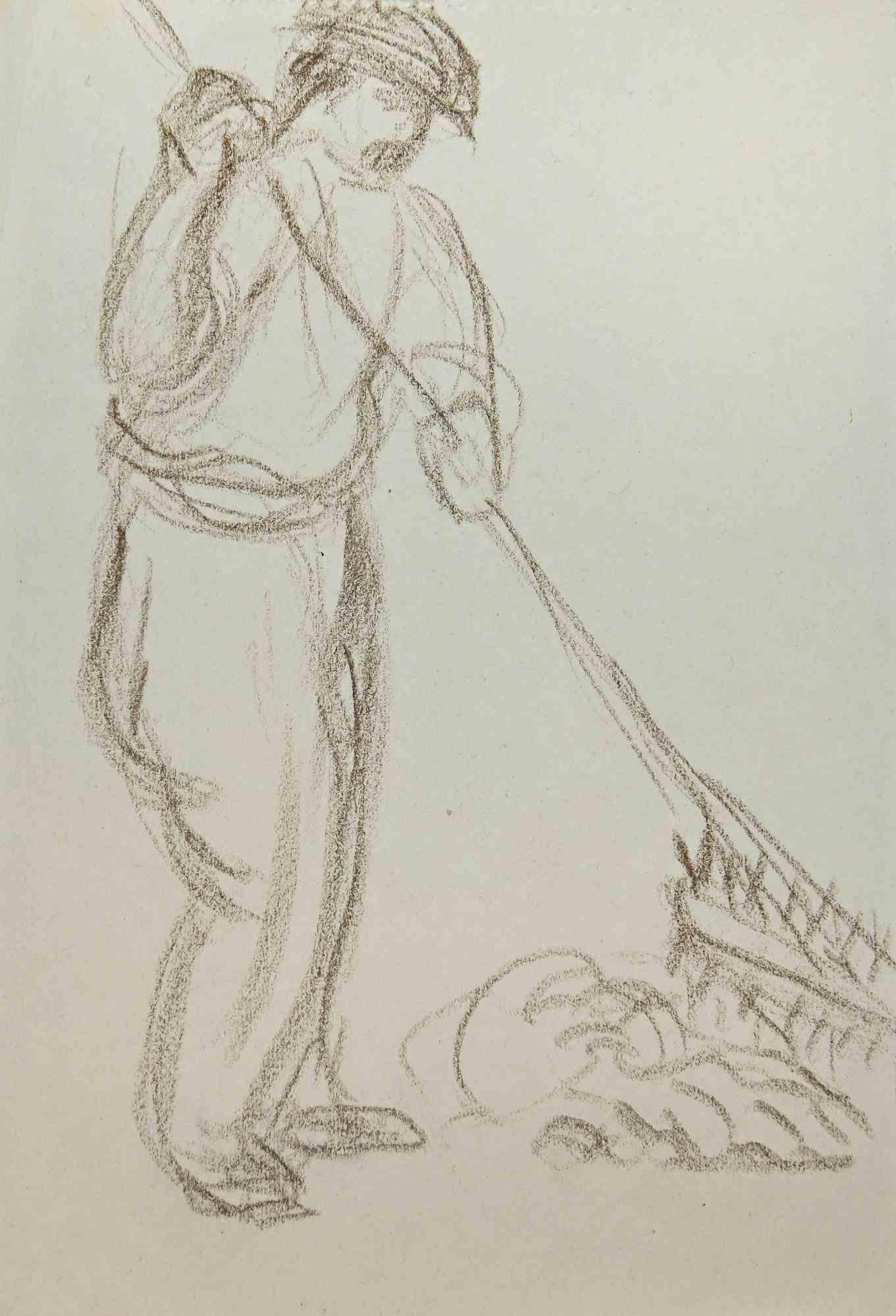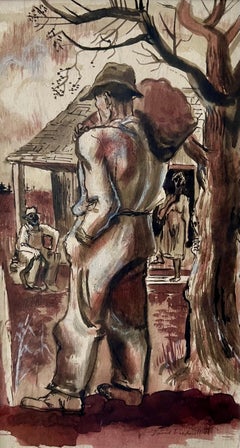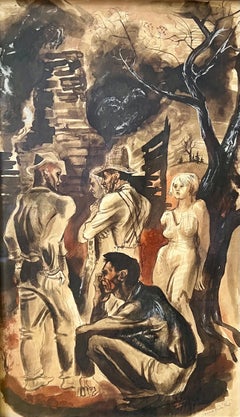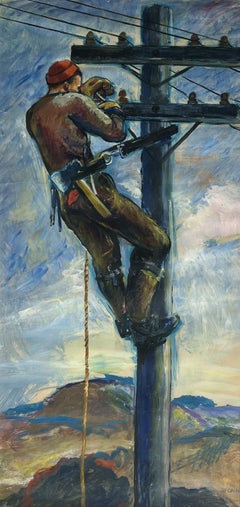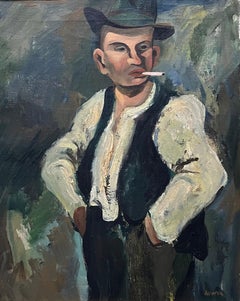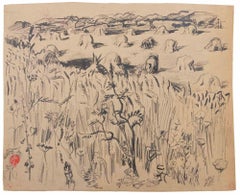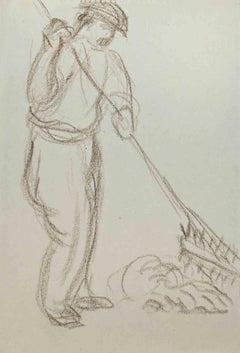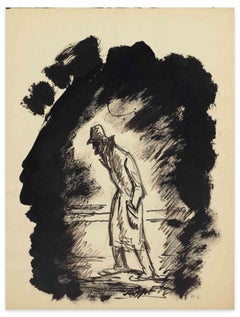Items Similar to TOBACCO ROAD Mid 20th Century Realism 1940 Drawing from the Novel WPA Literary 3
Want more images or videos?
Request additional images or videos from the seller
1 of 8
David FredenthalTOBACCO ROAD Mid 20th Century Realism 1940 Drawing from the Novel WPA Literary 31939
1939
$12,500
£9,426.24
€10,901.90
CA$17,537.43
A$19,493.95
CHF 10,218.31
MX$238,068.26
NOK 127,569.69
SEK 120,019.28
DKK 81,368.61
About the Item
TOBACCO ROAD Mid 20th Century Realism 1940 Drawing from the Novel WPA Literary 3
10 1/2 x 6 (sight), Signed David Fredenthal lower right. Framed by Lowy.
Offered here is one of several original drawings by WPA artist David Fredenthal that were first published in the 1940 illustrated edition of the novel TOBACCO ROAD by Erskine Caldwell.
Background on the Drawing
Erskine Caldwell remarked, on seeing the work of David Fredenthal, 26-year-old painter: "That boy could draw my Tobacco Road people." A casual comment, it was enormously productive.
The young painter was just finishing a two-year Guggenhcim Fellowship, preceded by a year's study in Paris, two one-man shows at New York's Downtown Gallery, and a fellowship at the Cranbrook Academy near Detroit. He was out in Colorado Springs when he heard what Caldwell had said about him.
Fredenthal hadn't read Tobacco Road. He had not even seen the play - now breaking all records in its seventh year on Broadway. But he swapped a portrait for a second-hand Ford and headed East.
In New York he learned that Dnell, Sloan & Pearce were bringing out a deluxe edition of Tobacco Road. But he had no entrée to the publishers, and Caldwell, to his disappointment, was out of town. So he drove on to Georgia to have a look at the Tobacco Road people.
He found Dr. I. C. Caldwell, the author's father, in Wrens, Ga., going on his ministerial rounds among people like the Lesters. Fredenthal got a room from a couple who ran a 1-pump filling station—and stayed two months.
He is a direct and unaffected person, not a prober into social problems. He asked no questions - just looked. At night he stopped at the town's bar, sat at a corner table, and drew what he had seen that day: sick people, unable to mend because of lack of nourishment; an old palsied woman picking peas to get money for the medicine the doctor ordered: families housed five in a room - plus a cur dog or two; families at table; men skinning down a pig; women gathering fire woods; some just settin', or making away with a jug of corn.
These drawings he sent back to Caldwell. Caldwell turned them over to the publishers, who sent for the artist and ordered 40-odd pen and ink drawings and six in color to illustrate the text. When the publishers said some of the finished drawings were too raw—contained too many buttocks—Caldwell said: "Give the kid a free hand. He's seen it. He knows what he's drawing."
The publication of the new edition of Tobacco Road. on Nov. 8 is a moment of triumph for young Fredenthal. He grabbed the ball and ran off ahead of a field of Bentons and Woods and many bcttcr-known artist-illustrators.
Now he likes to illustrate books. Books about elemental people. He can draw from vivid memories: sailors on the Great Lakes, freighters, men on the Ford Plant assembly line, denizens of flop houses where he lived when distributing Christmas cards
for $4 a week. He can draw his fellow C.C.C. workers in the first gang to go out in '33 - laying lines, building roads and state parks, fighting fire.
Like most artists, Fredenthal is a hopelessly bad businessman and always broke. "Anyway", he says, "there's a regular pay check to be had from the army - if it has to come to that “
- Maude Riley
CUE - The Weekly Magazine of New York Life (vol. 9 #46, Nov. 1940)
David Fredenthal (1914 - 1958) was one ot America's most respected watercolor artists. He was famous tor his bold, intensely vigorous and complex paintings and drawings that expressed his deep feeling for excitement with life and living. He was a brilliant natural draftsman with a special gift for catching anything, physically and emotionally on the spot, and he never went anywhere without three or four loaded pens and a sketchbook in his pocket.
As part of the WPA project he executed a number of murals including Five large panels in fresco under the Federal Art Project in the Brodhead Naval Armory, Detroit, MI, 1937.
The Sports Pavilion on the Heinz Building of the New York World's Fair 1939. Some of his fresco and mural techniques were inspired by his friendship with Diego Rivera who had admired and encouraged him in the early1930's.
After he won a traveling scholarship to Europe from The Museum of Modern Art at age 19, he was the recipient of two Guggenheim grants in Painting. He had his first solo exhibition at the Downtown Gallery in New York in 1937 atage 23 and many others after that including the Whitney Museum of American Art in 1947.
Because of Fredenthal's prodigious drawing gifts, he was chosen by Erskine Caldwell to illustrate his novel “Tobacco Road” in 1940. He was a War Artist Correspondent for both the State Department (the European and Asian fronts) and Life magazine from 1943 to 1946 and his work was featured in Life Magazine regularly during the war and after until the end of his life.
Also featured in Life in 1956 were drawings that Fredenthal had vividly recorded on his sketch pad, of the entire filming of the movie, “The Pride and the Passion,” starring Cary Grant, Sophia Loren, and Frank Sinatra, along the treacherous mountain passes of Spain.
Though he was fiercely committed to an art that expressed deeply human social values and issues and was quite hostile to abstraction, he was friendly with a number of abstract artists such as David Smith, Ad Reinhardt, Philip Guston, Paul Feeley, and Herman Cherry and was very admired and respected by them as one of art history's great draftsmen.
- Creator:David Fredenthal (1914-1958, American)
- Creation Year:1939
- Dimensions:Height: 21 in (53.34 cm)Width: 16 in (40.64 cm)Depth: 2 in (5.08 cm)
- Medium:
- Movement & Style:
- Period:
- Condition:
- Gallery Location:New York, NY
- Reference Number:1stDibs: LU115629761682
About the Seller
5.0
Gold Seller
Premium sellers maintaining a 4.3+ rating and 24-hour response times
Established in 2008
1stDibs seller since 2019
195 sales on 1stDibs
Typical response time: <1 hour
- ShippingRetrieving quote...Shipping from: New York, NY
- Return Policy
Authenticity Guarantee
In the unlikely event there’s an issue with an item’s authenticity, contact us within 1 year for a full refund. DetailsMoney-Back Guarantee
If your item is not as described, is damaged in transit, or does not arrive, contact us within 7 days for a full refund. Details24-Hour Cancellation
You have a 24-hour grace period in which to reconsider your purchase, with no questions asked.Vetted Professional Sellers
Our world-class sellers must adhere to strict standards for service and quality, maintaining the integrity of our listings.Price-Match Guarantee
If you find that a seller listed the same item for a lower price elsewhere, we’ll match it.Trusted Global Delivery
Our best-in-class carrier network provides specialized shipping options worldwide, including custom delivery.More From This Seller
View AllTOBACCO ROAD Mid 20th Century Realism 1940 Drawing from the Novel WPA Literary 2
By David Fredenthal
Located in New York, NY
TOBACCO ROAD Mid 20th Century Realism 1940 Drawing from the Novel WPA Literary 2
10 1/2 x 6 (sight), Signed David Fredenthal lower right. Framed by Lowy....
Category
1930s American Realist Figurative Drawings and Watercolors
Materials
Paper, Ink, Watercolor
"Tobacco Road" Mid 20th Century Realism 1940 Drawing from the Novel WPA Literary
By David Fredenthal
Located in New York, NY
"Tobacco Road" Mid 20th Century Realism 1940 Drawing from the Novel WPA Literary
19 1/4 x 11 1/2 (sight), Signed David Fredenthal lower right. Framed by ...
Category
1930s American Realist Figurative Drawings and Watercolors
Materials
Paper, Ink, Watercolor
Man Working Mid 20th Century American Scene Social Realism Industrial WPA Modern
By Jo Cain
Located in New York, NY
Man Working Mid 20th Century American Scene Social Realism Industrial WPA Modern
Jo Cain (1904 - 2003)
Telephone Pole Worker
38 1/4 x 18 1/2 inches
Oil on pap...
Category
1930s American Realist Figurative Drawings and Watercolors
Materials
Paper, Gouache
"Unemployed" WPA American Scene Social Realism Mid 20th Century Modern
By William Gropper
Located in New York, NY
"Unemployed" WPA American Scene Social Realism Mid 20th Century Modern
William Gropper (1898 - 1977)
Unemployed
20 x 16 inches
Oil on canvas, 1937
Signed lower right
Provenance: Estate of the artist
Bio
Throughout his life, William Gropper used his artistic talents to protest social injustice. Born in New York City, he grew up there in poverty and left high school to work as a dishwasher and delivery boy. He eventually began a career in art and was able to study with Robert Henri and George Bellows from 1912 to 1915. He adopted their realistic painting style, and his own work expressed sympathy for common laborers and outrage at society's ills.
In 1919 Gropper established a reputation as a political cartoonist working for the New York Tribune. His blunt, forceful style attracted the attention of other publications, and he provided illustrations and cartoons for a variety of magazines, from the left-wing New Masses to mainstream Vanity Fair. Like many social realist artists of the 1930s, Gropper supported liberal political causes, depicting subjects such as the plight of migrant laborers and striking factory workers.
In his first gallery exhibition in 1936 at ACA Galleries, Gropper's work was so well received by critics, collectors, and artists that the following year he had two one-man exhibitions at ACA Galleries. In 1937, Gropper traveled west on a Guggenheim Fellowship and visited the Dust Bowl and the Hoover and Grand Coulee Dams, sketching studies for a series of paintings and a mural he painted for the Department of the Interior. That same year he had paintings purchased by both the Metropolitan Museum of Art and the Museum of Modern Art.
Gropper exhibited at the 1939 New York World's Fair, Whitney Museum of American Art (1924-55), Art Institute of Chicago (1935-49), Carnegie International (1937-50), Pennsylvania Academy of the Fine Arts (1939-48), and National Academy of Design (1945-48). He was a founder of the Artists Equity Association and member of the National Institute of Arts and Letters.
From 1940 to 1945 William Gropper was preoccupied with anti-Nazi cartoons...
Category
1930s American Realist Figurative Paintings
Materials
Canvas, Oil
"Good Health Week" American Scene Modern Social Realism Mid 20th Century WPA Era
By Jo Cain
Located in New York, NY
"Good Health Week" American Scene Modern Social Realism Mid- 20th Century WPA Era
Jo Cain (1904 – 2003)
Good Health Week – b/w
10 ½ x 15 1/2 inches
I...
Category
1930s American Realist Figurative Drawings and Watercolors
Materials
Paper, Ink
Railroad Worker Industrial WPA American Scene Mid Century Modern Social Realism
By Jo Cain
Located in New York, NY
Railroad Worker Industrial WPA American Scene Mid Century Modern Social Realism
Jo Cain (1904 - 2003)
Railroad worker
36 ¼ x 27 inches
Oil on paper c. 1930s
S...
Category
1930s American Realist Figurative Drawings and Watercolors
Materials
Paper, Oil
You May Also Like
Country Scene - Drawing by Suzanne Tourte - 1940s
Located in Roma, IT
Country scene is an artwork realized by Suzanne Tourte, in 1940s.
Pen and pencil on paper.
artist's stamp on the left side.
20 x 24 cm.
Good cond...
Category
1940s Modern Figurative Drawings and Watercolors
Materials
Pen, Pencil
Countryside - Charcoal Drawing - Mid-20th Century
Located in Roma, IT
Countryside is a pencil drawing realized by a french artist in the mid-20th Century.
Good conditions on a white paper.
No signature.
Category
1960s Modern Figurative Drawings and Watercolors
Materials
Pencil
Farmer - Original Drawing - Mid-20th Century
Located in Roma, IT
Farmer is an original Drawing in pencil on creamy-colored paper realized by an anonymous artist in the Mid 20th century.
Good conditions.
The artwork is represented posing nude thr...
Category
Early 20th Century Modern Figurative Drawings and Watercolors
Materials
Pencil
Into The Night - Drawing - 1950s
Located in Roma, IT
Into The Night is a watercolor and ink Drawing realised in the 1950s and attributed to Otakar Coubine.
Monogrammed on the lower
With another drawing in pencil on the rear.
Goo...
Category
1950s Modern Figurative Drawings and Watercolors
Materials
Paper
Farmer at Work - Watercolor - Early 20th Century
Located in Roma, IT
Farmer at Work is an original watercolour realized by a French artist of the early 20th Century.
The artwork is in good conditions, except for some worn margin, and it is mounted on...
Category
Early 20th Century Modern Figurative Drawings and Watercolors
Materials
Watercolor
Camp Northampton, Second World War charcoal sketch
Located in London, GB
Anonymous
Camp Northampton
Charcoal sketch
34 x 43 cm
At first glance, this charcoal sketch seemingly depicts three barns lining a country lane. The scene seems idyllic, trees a...
Category
Mid-20th Century Realist Landscape Drawings and Watercolors
Materials
Charcoal
More Ways To Browse
1939 Fair
Literary Art
New York Worlds Fair 1939
Brown Line Drawing
Line Drawing Of Women
Mid Century Kids
Midcentury And Detroit
The Offs First Record
1939 Pen And Ink
David Ford
Road Sign Table
Cary Grant
Wpa Mural Study
1930 Social Realism
Wpa Paintings Social Realism
Frank Sinatra Paintings
Painting Of Sinatra
Odd Fellows
